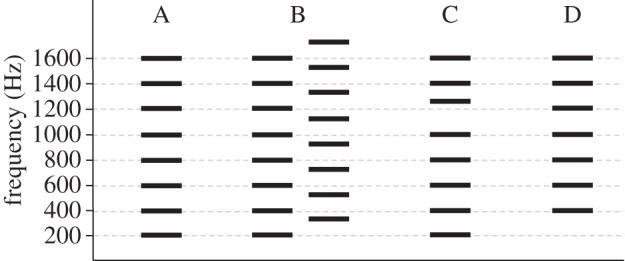Figure 1.

Harmonic structure and determining the number of auditory objects with simultaneous sound inputs. (A) A complex tone with fundamental frequency (f0) at 200 Hz and harmonics at integer multiples of f0, which is perceived as a single tone (auditory object) with a pitch of 200 Hz. (B) Two complex tones (sound sources) with f0s at 200 and 260 Hz and their harmonics. It can be seen that their harmonics overlap in frequency range, so when they simultaneously impinge on the ear, the auditory system must decompose the incoming sound into its frequency components and use its knowledge of harmonic structure to recombine them into representations of the original sound sources. (C) That the brain uses harmonicity to determine the number of auditory objects can be seen by mistuning one harmonic of the 200 Hz complex tone shown in (A). In this case, two tones are heard. The mistuned harmonic is heard as one auditory object and the remaining components, which are all integer multiples of f0, fuse into a second auditory object. (D) Pitch of the missing fundamental: the brain creates the sensation of pitch as can be seen in that when f0 is removed from a complex tone stimulus, the perceived pitch remains at f0.
